
Concept explainers
(a)
Interpretation: The Fischer projection formula for
Concept introduction: The Fischer formula can be drawn by using the following rules.
- Ø The chiral center is assumed to be in the plane of paper.
- Ø Two of the bonds are considered pointing towards the page.
- Ø Two of the bonds are considered pointing outwards of the page.
- Ø The intersection of horizontal and vertical lines represents the chiral centre.
- Ø The horizontal lines are the lines pointing outwards of the page.
- Ø The vertical lines are the lines pointing towards the page.
(a)
Answer to Problem 18.63EP
The Fischer projection formula for
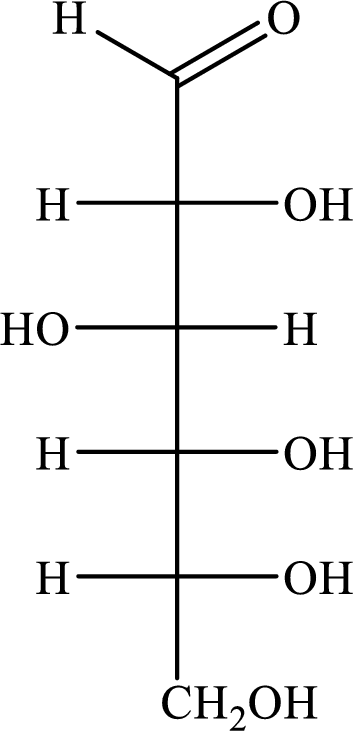
Explanation of Solution
The given molecule is
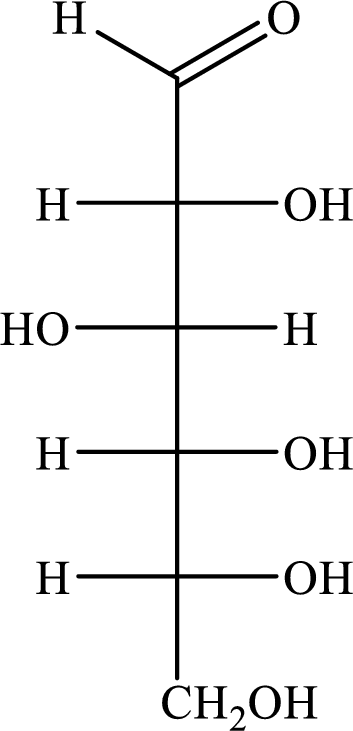
The monosaccharide,
(b)
Interpretation: The Fischer projection formula for
Concept introduction: The Fischer formula can be drawn by using the following rules.
- Ø The chiral center is assumed to be in the plane of paper.
- Ø Two of the bonds are considered pointing towards the page.
- Ø Two of the bonds are considered pointing outwards of the page.
- Ø The intersection of horizontal and vertical lines represents the chiral center.
- Ø The horizontal lines are the lines pointing outwards of the page.
- Ø The vertical lines are the lines pointing towards the page.
(b)
Answer to Problem 18.63EP
The Fischer projection formula for
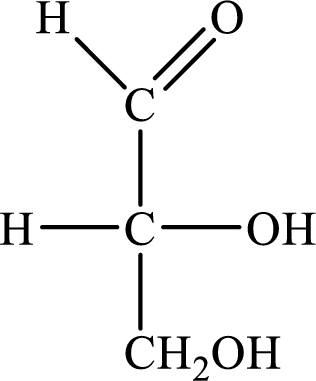
Explanation of Solution
The given molecule is
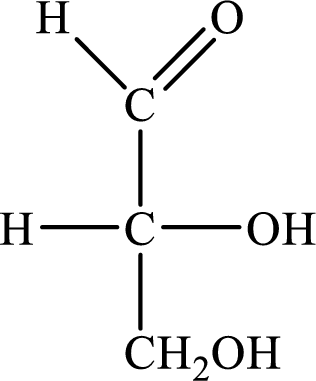
The monosaccharide,
(c)
Interpretation: The Fischer projection formula for
Concept introduction: The Fischer formula can be drawn by using the following rules.
- Ø The chiral center is assumed to be in the plane of paper.
- Ø Two of the bonds are considered pointing towards the page.
- Ø Two of the bonds are considered pointing outwards of the page.
- Ø The intersection of horizontal and vertical lines represents the chiral center.
- Ø The horizontal lines are the lines pointing outwards of the page.
- Ø The vertical lines are the lines pointing towards the page.
(c)
Answer to Problem 18.63EP
The Fischer projection formula for

Explanation of Solution
The given molecule is

The monosaccharide,
(d)
Interpretation: The Fischer projection formula for
Concept introduction: The Fischer formula can be drawn by using the following rules.
- Ø The chiral center is assumed to be in the plane of paper.
- Ø Two of the bonds are considered pointing towards the page.
- Ø Two of the bonds are considered pointing outwards of the page.
- Ø The intersection of horizontal and vertical lines represents the chiral center.
- Ø The horizontal lines are the lines pointing outwards of the page.
- Ø The vertical lines are the lines pointing towards the page.
(d)
Answer to Problem 18.63EP
The Fischer projection formula for
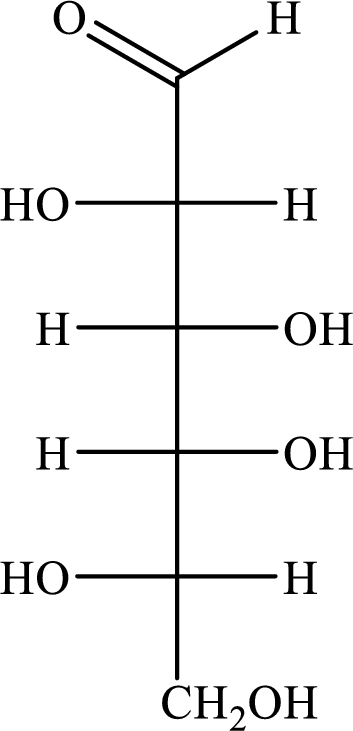
Explanation of Solution
The given molecule is
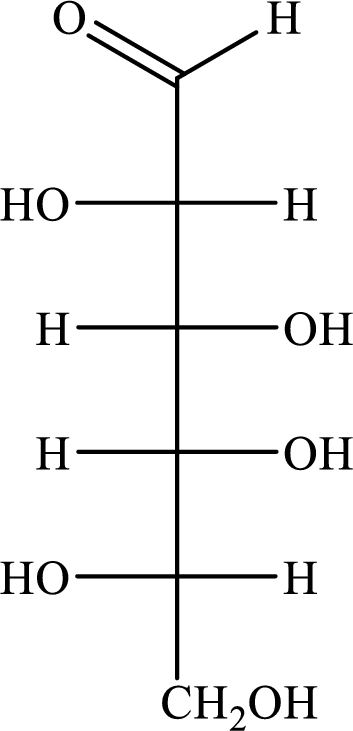
The monosaccharide,
Want to see more full solutions like this?
Chapter 18 Solutions
General, Organic, and Biological Chemistry Seventh Edition
- Identify the name of each of the structures of sugar and identify as reducing or nonreducing sugar. One of the structures may be not identified from the usual structures of disaccharides. Kindly answer a, b, c, and d.You only identify the name of each structure of sugars and identify as reducing or nonreducing sugar. No explanation needed.arrow_forwardPage 3 of 6 Previous Next For items 16-20, determine the monosaccharide units for each carbohydrate. Choic are: A. B-D-galactopyranose, and D-glucopyranose B. a-D-glucopyranose and D-glucopyranose C. N-acetyl-galactosamine D. B-D-glucuronate-2-sulfate, E. N-acetyl-B-D-glucosamine, and D-glucuronate 16. Maltose 17. Lactose and N-sulfo-D-glucosamine-6-sulfate 18. A-antigen oligosaccharide (end unit) 19. Heparin 20. Hyaluronic acid 344arrow_forwarddraw a fischer projection formula for the enantiomer of each of the following monosaccharides.arrow_forward
- Describe the structural similarities and differences of the following pairs. Identify which of these is a structural isomer, and how to identify structural isomers. a. Glucose and Mannose b. Galactose and Fructose c. Ribulose and Xylulose d. ribose and glucosearrow_forwardName the following compound: HO HO H H OH H. OH но он ÓH H HO, а. Ketose b. Maltose c. Sucrose d. Aldosearrow_forwardDraw the Fischer projection formula for each sugar and give the importance/use of each. 1. D- glyceraldehyde 2. D- erythrose 3. D- ribose 4. D- deoxyribose 5. D- glucose 6. D- galactose 7. D- fructose 8. D- ribulosearrow_forward
- Consider the following statements: (1) The term sugar is a general designation for both monosaccharides and disaccharides. (2) The "penultimate carbon" in a monosaccharide is used to determine D- or L-configuration. (3) Sucrose is a reducing sugar and lactose is a nonreducing sugar. O Two of the three statements are true. All three statements are true. O Only one of the statements is true. None of the statements are true.arrow_forwardHow many stereoisomers are possible for the following monosaccharide? a. 4 b. 8 c. 16 d. 2 e. 1arrow_forwardUsing the tree structures for the following monosaccharides and comparing to that for glucose, draw the structures of the following: A. tree (Fischer) structures of: D-mannose and L-mannose B. ring structures of alpha-D-mannose, beta-D-mannose, alpha-L-mannose, and beta-L-mannose Draw the ring (Haworth) structures as 6-membered pyranoses, being careful to show the positions of the hydroxyl groups above or below the plane of the ring.arrow_forward
- Cellulose is a large polysaccharide containing many alpha(1→4) glycosidic linkages and alpha(1→6) glycosidic linkages. True or False?arrow_forwardIdentify the component monosaccharides of each of the following compounds and describe the type of glycosidic linkage in each.arrow_forwardListed below are descriptions that may belong to amylose, amylopectin, both, or it may not belong to either. Write A if it describes amylose, B if it describes amylopectin, AB if the statement applies to both, or O if it doesn’t apply to either. 1. Its monosaccharides are bound by at least one α-1,4-glycosidic bond. 2. It contains α-1,6-glycosidic bonds. 3. It can be broken down by the enzyme α-amylase. 4. A polysaccharide made up of gulose. 5. It can form a double helix.arrow_forward
 Biology Today and Tomorrow without Physiology (Mi...BiologyISBN:9781305117396Author:Cecie Starr, Christine Evers, Lisa StarrPublisher:Cengage Learning
Biology Today and Tomorrow without Physiology (Mi...BiologyISBN:9781305117396Author:Cecie Starr, Christine Evers, Lisa StarrPublisher:Cengage Learning
